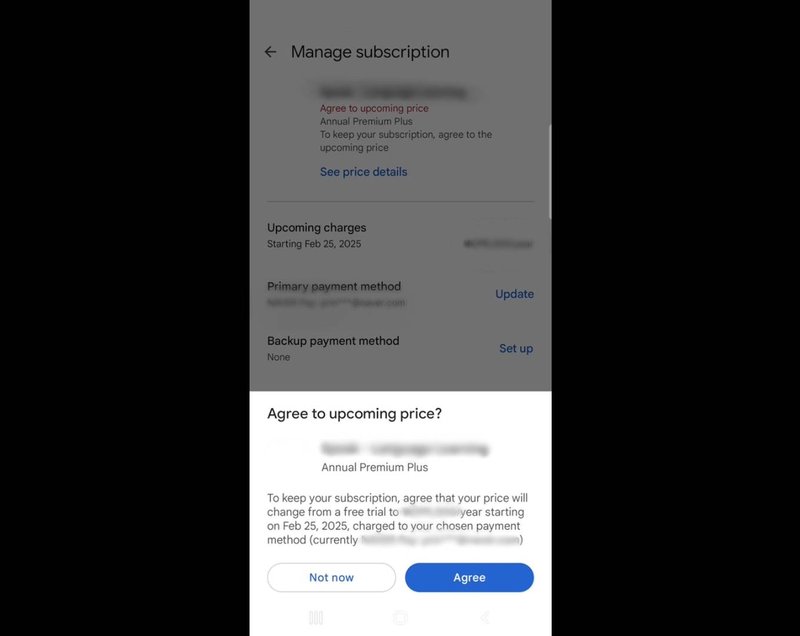Are subscription trials dead in South Korea? What developers need to know about the country’s new subscription rules
South Korea’s updated regulations are redefining free trials and subscription renewals: What you should know

Since February 14, 2025, South Korea has begun rolling out new regulations that dramatically change how in-app subscriptions and free trials operate in the country. While these requirements are designed to protect users and promote transparency, the initial impact on performance was devastating across 700+ RevenueCat powered apps that saw trials start in the country since
In this article, we’ll look at the main points of the new regulations, share some recent RevenueCat data for the country, and propose strategies to keep your subscriptions thriving in South Korea. Let’s dive in
Why Are We Seeing New Regulations in South Korea?
The impetus behind these updated rules is South Korea’s amended Electronic Commerce Act, which focuses on stopping “dark patterns” (deceptive UI or marketing tactics) and requiring more explicit user consent for subscription payments . As free trials with automatic renewal grew more prevalent, consumers began expressing concerns about being charged unknowingly—so the government stepped in to ensure that users have a clear, proactive way to confirm whether they want to continue their subscription or cancel
What Exactly Changed?
1. Strict Enforcement Against “Dark Patterns”
South Korea’s Fair Trade Commission published a Q&A outlining six prohibited practices that manipulate user behavior:
- Hidden renewal (auto-renewing free trials without prominent disclosure)
- Sequential price disclosure (revealing additional charges only at later stages)
- Pre-selection of certain options (forcing opt-ins by default)
- Incorrect hierarchy (making the “purchase” button big and bright, while making “cancel” tiny and hard to find)
- Interference in cancellation or withdrawal (multiple, complicated steps just to cancel)
- Repeated coercion (bombarding users with pop-ups to reverse a cancellation or repeatedly soliciting personal data consent)
These patterns are specifically banned, with fines up to 5 million KRW (~$5,000) for noncompliance
2. Explicit Consent for Trials and Introductory Offers

Apps that offer a free trial or a discounted “intro” period must obtain explicit confirmation from the subscriber before the final conversion to a paid plan
- Apple requires that you obtain consent within 30 days from the subscriber’s payment or conversion date for free-to-paid trials or discounted-to-standard pricing (announced here)
- Google mandates that, for users in South Korea, confirmation of the first paid charge must occur within the last 14 days of a free trial, and 30 days before the discounted plan steps up to regular pricing (announced here)
If a user does not actively confirm, the subscription is canceled automatically at the end of the trial
3. User-Friendly Cancellation (No More “Incorrect Hierarchy”)
Developers must ensure the cancellation path is no more cumbersome than the purchase path. If the “buy” button is large and obvious while the “cancel” or “opt out” button is tiny or hidden, that’s considered a dark pattern under “incorrect hierarchy”. Similarly, you cannot bury your cancellation page behind multiple steps that far exceed the ease of the sign-up flow. Note that, even if users need to cancel your subscription with Google or Apple, this rule could be interpreted to mean that you’re responsible for
4. Restrictions on Pausing Subscriptions
Users will not be allowed to pause their subscription during free trials, discounted periods, or pending price changes. If a subscription was paused before February 14, 2025, it cannot be resumed prior to its scheduled date
5. Platform-Managed Consent Prompts
Apple and Google have both stated they will handle user notifications—via email, push, and in-app prompts—to inform customers of the upcoming charge and request their consent. While that relieves some workload for developers, it also leaves less room for last-minute “save” tactics if the user is on the fence. You’ll want to craft your paywall and messaging so the value of continuing is crystal clear
RevenueCat Trial Conversion Data
To assess the impact of these changes, we pulled data from both iOS and Android trials of varying lengths (5–9 day vs. ≤4 day) leading into mid-February 2025. Here’s a snippet of conversion rates during that period:
| Trial start date | Android: 5-9 day trial | iOS: 5-9 day trial | Android: <=4 day trial | iOS: <=4 day day trial |
| 2025-01-31 | 34.5% | 41.4% | 25.5% | 21.9% |
| 2025-02-01 | 34.7% | 41.9% | 23.1% | 23.1% |
| 2025-02-02 | 38.4% | 44.1% | 16.5% | 19.2% |
| 2025-02-03 | 37% | 44.5% | 17.1% | 22.8% |
| 2025-02-04 | 38.6% | 44.2% | 14.8% | 18.3% |
| 2025-02-05 | 39.6% | 46.1% | 19.3% | 21.7% |
| 2025-02-06 | 29.2% | 45.3% | 24.5% | 24.1% |
| 2025-02-07 | 1.6% | 44.6% | 23.9% | 19.8% |
| 2025-02-08 | 1.7% | 44.8% | 21.4% | 20.4% |
| 2025-02-09 | 1.9% | 44.2% | 23.7% | 17.6% |
| 2025-02-10 | 1.7% | 45.2% | 16.4% | 20.9% |
| 2025-02-11 | 2.1% | 43.7% | 0.7% | 18.5% |
| 2025-02-12 | 1.8% | 43.2% | 1.7% | 21.9% |
| 2025-02-13 | 1.9% | 43.1% | 0% | 20.9% |
| 2025-02-14 | 3.3% | 43.1% | 0.7% | 18.7% |
| 2025-02-15 | 3.4% | 42.1% | 0% | 17.3% |
| 2025-02-16 | 0% | 0.3% | 0.7% | 17.9% |
| 2025-02-17 | 0% | 0.4% | 0% | 13.5% |
Interestingly, right after the FTC’s crackdown on dark patterns and user-facing consent prompts began to appear, Android’s 5–9 day trial conversion rate dipped sharply, while iOS rates stayed comparatively stable. The discrepancy could reflect differences in how Google surfaces user consent screens—or the unique demographics of Android vs. iOS users in Korea (we’re waiting to see examples of how the consent flow is implemented on iOS). Either way, there’s a clear signal that on Google Play specifically (the most important platform in South Korea), trials have run into a roadblock
As of right now (February 23), there’s no sign that messages related to the consent process or progress is surfaced for developers via real-time developer notifications on Google Play. We’ve reviewed several thousand notifications around trials kicked off in the country, and found no useful information, though it’s worth noting that almost all trial expirations from Play since February 14th have had cancel reason ‘billing error’. In some cases, we see users opt in to new, no-trial subscriptions straight after
It’s Not All Doom and Gloom
Despite big headlines about new regulations that hamper auto-renewals, this shift doesn’t necessarily mean free trials or subscriptions are “dead” in South Korea. For starters, on iOS they seem to be faring fine so far (though there’s a bit of uncertainty on Apple’s interpretation of these new rules). On the flipside, Play’s dramatic conversion drop doesn’t look like an acceptable end-state for trials on the platform, so we’d expect to see some changes there over the coming weeks
For now, and until there are signs that Google Play’s consent flow starts working, we suggest developers adopt their local trial strategy. Something which is configurable directly from the RevenueCat backend using Targeting (shameless product plug: sorry)

Three Ways to Adapt Your Trial Strategy
- Keep Traditional Auto-Renew Trials—But Be Upfront
You can continue to offer an automatically converting trial. Just be sure your paywall and in-app messaging clarify the timeline and next steps. For instance, you could follow Blinkist’s lead by providing micro-prompts letting users know how many days remain, and ensuring they’re fully aware of what happens if they do (or don’t) confirm - Experiment with No-Trial or “Dual” Paywall Options
Try listing both a plan with a free trial and a cheaper plan without a trial, side by side. While some users may still opt for the free trial, others might choose the discounted plan immediately, thus avoiding any free-trial compliance complications. Even a small discount can entice cost-conscious users who prefer a straightforward subscription to the “uncertainty” of a trial they must confirm later - Consider a Reverse Trial
In a reverse trial, new users automatically enjoy premium features for a set period, but they’re not charged unless they explicitly sign up after that. This sidesteps the auto-renewal problem. The trade-off is that you need a strong conversion funnel to remind people to opt in before the free period ends. Check out Jacob Rushfinn’s excellent writeup on how Ladder implemented this practice on his blog
Action Items and Final Takeaways
- Audit Your Current Subscription Setup: Double-check any free trials or discount periods that renew at higher prices. If you’re exclusively selling on mobile, Google and Apple ‘take care’ of consent for you, but you’ll want some awareness as we’ve seen that performance might take a hit
- Message automatically cancelled trialists: As it stands, it very much looks like something might be broken for trial conversions on Google Play. We see a share of these same users manually buy a new (non-trial) subscription the day after the cancellation for some apps. If you want to make sure that users are aware of this option, retarget cancelled and expired trials with an offer shortly after
- Revisit Paywall and UI: Make sure your design doesn’t fall under any of the six banned “dark patterns,” including repeated coercion or incorrect hierarchy. Buttons for “cancel” or “opt out” should be just as visible as “buy.”
- Use RevenueCat or Similar Tools: RevenueCat’s real-time monitoring and aggregated data can help spot any drops in conversion related to new user-consent steps. You’ll see quickly if your approach needs tweaking
- Double Down on Messaging: Since users have to confirm anyway, use that prompt as a moment to remind them of your app’s value—highlight the premium features, ensure your UI is frictionless, and reduce confusion around recurring charges
- Stay Proactive: Some suspect these regulations could spread beyond Korea. If you’re prepared now, you’ll be better positioned if other markets adopt similar rules
While these subscription changes do add friction, they can also foster a more trusting relationship with users. By clearly explaining your value and respecting their decision-making process, you stand to gain long-term loyalty. Rather than viewing this as a headache, consider it a chance to sharpen your onboarding, messaging, and trial UX
You might also like
- Blog post
Modeling attribution on iOS: what works, what doesn’t, and how to choose
How to navigate the messy world of SKAN, AEM, and probabilistic attribution — plus two practical frameworks to get a clearer picture of campaign performance.
- Blog post
Your sprints must pay for themselves: Dan Layfield’s product advice
What’s worth building? Dan Layfield shares a 3-bucket framework to help app teams prioritize features, fix churn, and ship faster.
- Blog post
Is monetization hurting your app’s user experience?
Don’t trade short-term revenue for long-term trust. How ethical UX can still drive effective monetization.

